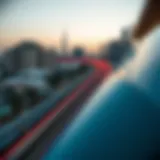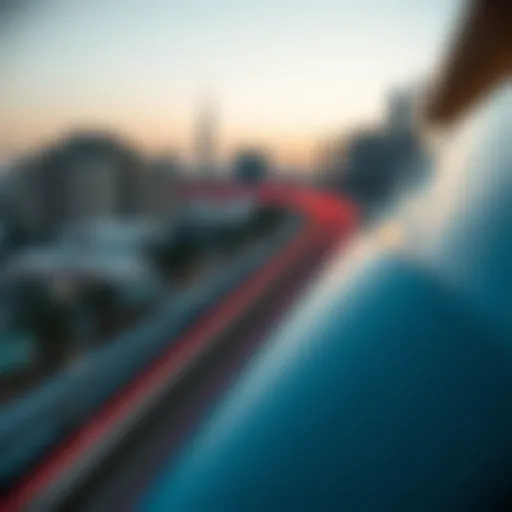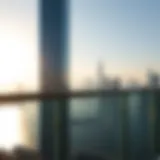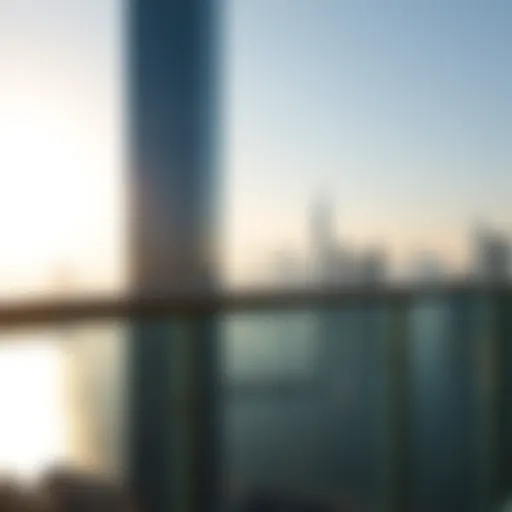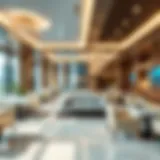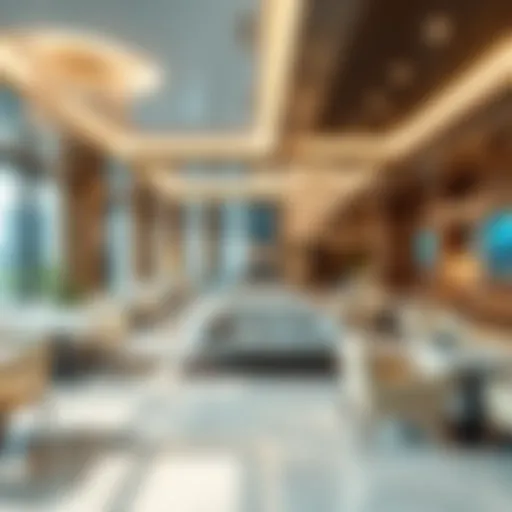Exploring the Depths of Dubai's Architectural Landscape
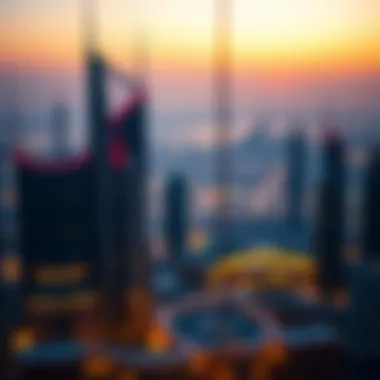

Intro
Dubai is a city that constantly evolves, adorned with towering skyscrapers, luxurious shopping malls, and an ever-changing landscape. Its cityscape is more than just a visual feast; it stands as a testament to the rapid socio-economic changes that have occurred over the last few decades. As potential investors, homebuyers, agents, and analysts gaze upon this metropolis, understanding its complex market dynamics is crucial for making informed decisions.
Every corner of Dubai's city skyline tells a story of ambition, innovation, and cultures intertwined with modern aspirations. Real estate trends here have become a hot topic, and the ongoing developments enhance the narrative of a city daring to reach new heights—literally and metaphorically.
This article aims to unravel the layers of Dubai's architectural wonders, the shifting patterns in property markets, and the vital interplay between urban planning and cultural reflection. Through detailed sections, readers will gain a richer understanding of how Dubai's vibrant landscape serves as both a housing hub and a cultural melting pot, influencing both local lives and international investments.
Understanding Dubai's Urban Fabric
Dubai's urban fabric plays a pivotal role in comprehending the complexities that define this global city. It is an intricate blend of culture, history, and modernity that influences various facets, from real estate to lifestyle choices. Understanding this urban fabric sharpens awareness about how the city has evolved and the factors driving its growth alongside the pressures that accompany rapid change.
Historical Context of Urban Development
The historical context of Dubai's urban development is a tale woven with innovation and resilience. Once a quiet fishing village, Dubai surged into a metropolitan powerhouse through strategic initiatives and visionary leadership.
In the early days, the city was characterized by simple structures made of coral and palm fronds, reflecting its maritime culture. However, the discovery of oil in the mid-20th century triggered a transformative wave, revolutionizing infrastructure and attracting foreign investments. Notably, Sheikh Rashid bin Saeed Al Maktoum's plans in the 1960s laid the groundwork for modern urban development, which fostered a rapid influx of people from varied backgrounds.
This multifaceted development not only brought skyscrapers and luxury resorts but also a blend of traditions through cultural exchanges. Each neighborhood narrates a distinct story, from the historic Al Fahidi area with its wind towers to the opulent developments on Sheikh Zayed Road, symbolizing Dubai's journey from simple to sophisticated.
Transformation into a Global Hub
Transformation into a global hub is an apt phrase to describe Dubai's emergence on the world stage. Through strategic investments in infrastructure and branding, the city successfully redefined its identity.
The establishment of the Dubai International Financial Centre in 2004 paved the way for the city to become a financial epicenter, thus attracting international firms and top-tier talent. Moreover, friendly business regulations and tax incentives created an attractive climate for foreign investment. This influx of capital has played a crucial role in shaping its cityscape.
Additionally, Dubai's commitment to hosting global events like Expo 2020 has showcased its capabilities as a host city. The infusion of diverse cultures and ideas from around the globe influenced not just the economic landscape but also added distinct flavors to community life.
Architectural Innovations and Designs
Dubai’s architectural landscape is a vivid tapestry embroidered with various styles, ideas, and functions. The city is a showcase of modern architectural achievements that has reshaped the collective imagination of urban design. Architectural innovations here are more than mere aesthetics; they embody a vision for sustainability, cultural resonance, and economic vitality. Dubai's design philosophy intertwines tradition with futuristic thinking, aiming not only to attract international admiration but also to define a new standard for urban living.
Iconic Structures of the Skyline
Burj Khalifa
As the tallest building in the world, Burj Khalifa stands as a symbol of Dubai's ambition. Towering at 828 meters, it exemplifies cutting-edge engineering and architectural finesse. Its key characteristic lies not only in its height but also in its unique design that resembles the Hymenocallis flower, which is native to the region. This reflects the city’s desire to root its modern achievements in local culture. The building boasts observation decks that offer breathtaking views, drawing tourists and residents alike. One unique feature of Burj Khalifa is its advanced wind turbine and cooling systems, allowing it to function efficiently in desert conditions. Despite its many advantages, such as tourism revenue and global recognition, it also brings concerns about maintenance costs and energy consumption on such a scale.
Burj Al Arab
The Burj Al Arab, often termed a 'seven-star hotel', represents luxury in the heart of the city. Its sail-like silhouette stands out against the skyline and signifies architectural daring. The hotel’s key characteristic is its opulence; from the lavish interiors to the refined service, it aims to provide guests an unparalleled experience. A unique feature is the underwater restaurant, allowing guests to dine surrounded by marine life. While this iconic structure attracts the elite and high-end travelers, it also raises questions about accessibility and the pressures of maintaining exclusivity in an increasingly diverse city.
Dubai Frame
Dubai Frame offers a unique opportunity to experience both old and new Dubai from a single vantage point. It acts as a bridge between the historical districts and modern skyscrapers. Its innovative design creates a picture frame, providing a literal and metaphorical view of the city’s evolution. The key characteristic of this structure is its duality, allowing visitors to see past and present simultaneously. One unique feature is the glass bridge at the top, giving a thrilling experience of walking above the city. Though it’s a relatively newer addition, it’s vital in showcasing Dubai's narrative while sparking a curiosity about its history.
Sustainable Architecture Practices
Eco-Friendly Initiatives
As urban areas expand, Dubai is stepping up its game in eco-friendly architecture. Various green building initiatives are being introduced to mitigate the environmental impact of urban sprawl. These initiatives often focus on renewable energy sources, waste reduction systems, and water conservation practices. The key characteristic of these initiatives is their focus on sustainability, aiming to pave the way for a greener future. A significant unique feature of these practices is the integration of smart technology to reduce energy consumption significantly. While they offer clear benefits such as reduced carbon footprints and long-term cost savings, the initial investments can be high, which sometimes deters smaller developers.
Smart Building Technologies
Smart building technologies are revolutionizing how structures operate, focusing on efficiency and performance. Buildings equipped with these technologies can monitor and optimize energy use, which is critical in a climate like Dubai’s. The key characteristic of smart buildings is their ability to adapt to the needs of the inhabitants, creating more comfortable and efficient living environments. An exciting unique feature is the use of AI for predictive maintenance, which helps in anticipating issues before they escalate into costly repairs. However, this integration does come with potential downsides, like the reliance on technology that could lead to vulnerabilities if not adequately secured.
The Role of Real Estate in Shaping the Cityscape
Real estate in Dubai isn't just a facet of the economy; it's a cornerstone of the city's identity and breathing life into its skyline. The architecture we see today is a product of brisk development, strategic planning, and an influx of global investments. As Dubai emerges as a hotspot for both luxury and practical living, understanding how real estate influences the cityscape can provide invaluable insights for potential investors and homebuyers.
Current Trends in Property Development
In the bustling heart of Dubai, property development is like a double-edged sword. With the demand for housing sharply on the rise, developers are experimenting with styles and formats that resonate with the modern urbanite.
- Luxury Living: High-end apartments and exclusive villas are sprouting up like daisies. Neighborhoods such as Palm Jumeirah and Dubai Marina showcase opulent designs, attracting affluent buyers from all corners of the globe.
- Affordable Housing: Interestingly, there’s also a surge in projects aimed at the middle class. Developers are recognizing the necessity for budget-friendly options. Areas like Dubai South are showcasing family-oriented developments that will likely appeal to both locals and expats.
- Smart Communities: Sustainability meets innovation in the realm of smart communities. The introduction of technologies that streamline living – from smart home features to community-focused analytical tools – is a key selling point.
As trends shift, staying up-to-date is crucial for those looking to step into the property market.
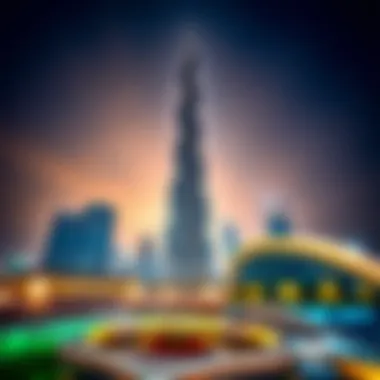

Impact of Foreign Investment on the Market
Foreign investment plays a significant role in the evolution of Dubai’s real estate market. The blend of cultures and ideas that come from international investors enrich the city's landscape and elevate its market to new heights.
Regulatory Framework
The regulatory framework surrounding foreign investment in Dubai is designed to foster growth while ensuring stability. This framework is not just a set of rules; it shapes investor confidence.
- Key Characteristic: One of the pivotal aspects is the allowance for 100% foreign ownership in designated free zones. This change has attracted a plethora of international investors eager to stake their claim in the lucrative Dubai market.
- Popular Choice: The framework's transparency is a massive draw for investors. With clear regulations, they can make informed decisions without second-guessing their investments.
- Unique Feature: However, complexities exist. Navigating through the bureaucracy can sometimes feel like an intricate maze. Investors need to be well-informed about the tax implications and legal stipulations to avoid unwelcome surprises.
Investment Opportunities
Investment opportunities in Dubai are as abundant as sand in the desert. The city's rapid growth and allure make it a prime location for sound investments.
- Key Characteristic: The diversification of the real estate portfolio is a strong suit. From commercial to residential spaces, the options are versatile, catering to various investor preferences.
- Beneficial Choice: As the city gears up for mega-events like Expo 2020 and future world-class attractions, the appreciation of property values in key locations is heartening.
- Unique Feature: One noteworthy feature is the evolution of co-living spaces. This trend reflects a shift in lifestyle preferences, especially among younger generations aiming for flexibility and community.
However, as with any investment, risks are involved, especially in a market that can be as volatile as a summer storm.
"Dubai’s real estate is more than just property; it’s a testament of aspirations, dreams, and the relentless pursuit of modernity."
Urban Planning and Infrastructure
Urban planning and infrastructure are crucial for maintaining and enhancing the intricate framework of Dubai's cityscape. The city's rapid growth and evolving identity rely heavily on strategic development and cohesive urban design. By addressing factors such as transportation, public amenities, and green spaces, planners aim to create a balanced environment that accommodates residents and visitors alike.
Effective urban planning facilitates communication between different neighborhoods, promotes economic growth, and enhances the quality of life for all. A well-structured infrastructure supports not just the micro-level, such as individual neighborhoods, but the macro-level, connecting the broader city with key resources and services.
Public Transport and Connectivity
Metro Expansion
The metro expansion is a vital component in fostering connectivity across the dynamic landscape of Dubai. With its innovative approach, the metro system has transformed how citizens and tourists navigate the city. The expansion project features the introduction of new lines and increased service frequency to meet the rising demand from a diversifying population.
One notable characterstic of the metro expansion is its integration with other forms of transport, including buses and water taxis. This seamless connection allows commuters to switch modes easily, enhancing their overall experience. The metro system, known for its affordability and speed, presents itself as an ideal choice for those looking to avoid the hustle of road traffic.
However, there are still areas for improvement. Despite its efficiency, some stations are critiqued for their limited accessibility, particularly for those with mobility challenges.
Accessibility Challenges
Accessibility challenges are an important area of consideration within urban planning. While Dubai boasts a robust infrastructural framework, there are limitations in providing equal access to all segments of the population. These challenges mainly arise from the city's rapid expansion and burgeoning traffic congestion, posing hurdles for certain communities.
One major characteristic of these accessibility challenges is the inconsistency in public transport availability. In some areas, service may be less frequent, resulting in longer waiting times. Furthermore, inadequate pedestrian pathways can restrict movement, making it hard for individuals to navigate the city safely.
Such factors can detract from the otherwise impressive urban layout, highlighting a need for ongoing assessments and improvements to ensure that every resident feels included in the city’s journey towards modernization.
Future Urban Development Projects
Downtown Dubai Revitalization
The Downtown Dubai revitalization project represents a significant leap into the future of urban development in the emirate. Focused on enhancing both functionality and aesthetic appeal, this initiative is set to transform one of the world’s most iconic urban hubs. By incorporating more green spaces, public areas, and pedestrian-friendly designs, the revitalization aims to attract a broader demographic.
A big draw of this project is the incorporation of cultural and recreational facilities, which elevates the urban experience beyond mere commercial interactions. Residents and tourists alike can expect a more vibrant environment that encourages community bonding and leisure activities. However, it remains to be seen how effectively the balance between development and maintaining local heritage can be achieved in practice.
Expo Legacy
The legacy of Expo 2020 is marking a monumental era for Dubai, both socially and economically. This international event has paved the way for diverse development projects that not only aim to showcase Dubai’s innovation but also address global issues like sustainability and inclusiveness. The main feature of this legacy is the long-term use of expo sites, transforming them into exhibition centers and community hubs after the event.
Positioned as a beneficial initiative, this repurposing catalyzes future urban growth, fostering connections within the city and with the world. While the aspirations behind the Expo 2020 legacy are commendable, questions about environmental impact, resource allocation, and ongoing community engagement remain pertinent as Dubai looks to maintain momentum from this global stage.
Overall, the intricate weave of urban planning and infrastructure in Dubai challenges conventional frameworks while setting precedence for future developments. These components are not just phases but the lifeblood of a city striving to maintain its place on the global map.
"Urban planning shapes a city's identity, reflecting its culture, aspirations, and values as much as its skyline."
This nexus of planning initiatives and continuous infrastructure upgrades ultimately supports the city’s journey into a sustainable urban future.
Lifestyle and Cultural Influences
Dubai, a city steeped in tradition yet bursting with modernity, mirrors the diverse influences surrounding it. Understanding lifestyle and cultural influences offers invaluable insights, especially when considering investment opportunities and potential relocation. It showcases how the rich tapestry of customs shapes the city's social fabric and urban design. This intricate blend not only attracts expatriates but also provides a unique backdrop for investors contemplating the local property market.
Residential Preferences Among Expats
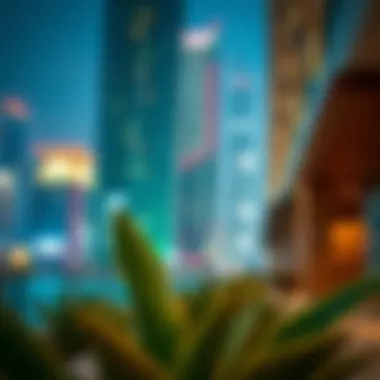

Popular Neighborhoods
The residential preferences of expatriates in Dubai significantly color the city's living spaces. Areas like Jumeirah, Dubai Marina, and Downtown Dubai epitomize luxury and convenience brimming with options for families and professionals alike. Each neighborhood has its own charm; for instance, Dubai Marina boasts upscale waterfront living, while Downtown Dubai offers direct access to the iconic Burj Khalifa.
Popular neighborhoods are often a prime choice for their vibrant ambiance. They typically feature a rich variety of amenities, from shopping malls to fine dining restaurants, making it easy for residents to forge a lifestyle resonant with cosmopolitan nuances. For potential investors or homebuyers, these areas often promise capital appreciation due to high demand.
However, one should note that the allure of these neighborhoods comes with a higher price tag, which can deter some who are just starting out.
Trends in Luxury Living
Luxury living in Dubai resonates deeply with the city's ethos, attracting affluent individuals seeking a lifestyle that transcends the ordinary. This trend is characterized by lavish apartments, lavish villas, and a range of high-end facilities, from infinity pools to personal concierge services. The hallmark of current luxury trends includes smart residences equipped with cutting-edge technology, enhancing comfort and convenience.
These luxurious offerings not only elevate the living experience but also contribute positively to investment potential. Developers continually seek to innovate, introducing unique features like automated home systems, thus aligning with the tech-savvy population.
However, potential buyers and investors need to carefully consider whether they want to stretch their budgets for such exclusivity, as the luxury market can be volatile, often influenced by global economic fluctuations.
Cultural Landmarks and Their Significance
Dubai Opera
One cannot discuss culture in Dubai without mentioning the remarkable Dubai Opera. Located in the heart of the city, this architectural marvel serves not only as a venue for world-class performances but also as a symbol of Dubai's ambition to be an international cultural hub. Its distinctive dhow-shaped structure represents a fusion of tradition and modernism, drawing both locals and tourists alike to its doorstep.
The Opera significantly enriches the social fabric of Dubai, promoting cultural exchange through a diverse array of events. Such venues create a pull for investors aiming to capitalize on the influx of visitors, enhancing the overall appeal of surrounding residential and commercial properties.
One must keep in mind that its popularity also means it can become crowded during major events, which may detract from the experience at times.
Al Fahidi Historical Neighborhood
In striking contrast to the shiny skyscrapers, Al Fahidi Historical Neighborhood is a window to Dubai's past. This area captures the essence of the emirate's heritage and offers a glimpse into its roots with its well-preserved wind-tower architecture and meandering lanes.
The neighborhood transcends mere historical interest, presenting unique opportunities for cultural tourism, which can be an attractive proposition for investors considering properties in or near this site. The juxtaposition of modernity against the historical backdrop adds complexity to Dubai's cityscape, making it even more alluring for expatriates seeking authenticity amidst rapid development.
However, renovations in this older area may present some challenges, such as limited facilities available and potential conflict between preserving heritage and meeting current urban living standards.
"Dubai’s essence lies in its ability to blend the old with the new, painting a vivid picture that reflects both its traditions and aspirations for the future."
Challenges Facing Dubai’s Cityscape
Analyzing the challenges that Dubai faces in its urban environment offers key insight into how this dynamic city is continually evolving. With rapid growth often comes obstacles—be it economic, environmental, or social. Understanding these challenges is crucial for investors and homebuyers who seek to make informed decisions in a market that is as promising as it is complex. By grappling with the nuances and implications of these issues, stakeholders can better navigate the landscape of Dubai's real estate and urban development.
Economic Fluctuations and Real Estate
Effects of Global Markets
In today’s interconnected world, Dubai is not an island; its economy is greatly influenced by global market trends. Economic stability or instability in major economies, such as the U.S., China, or the EU, can ripple through Dubai’s real estate sector. A significant downturn often leads to decreased foreign investment, which is vital for the city’s growth.
- Key characteristic: The reliance on external investments means that rapid global changes can create uncertainty.
- Advantages: For a savvy investor, understanding these global markets can provide opportunities to buy at lower prices during downturns.
- Disadvantages: On the flip side, such volatility can deter long-term commitments, making profitable ventures harder to predict.
Local Economic Impact
Another essential aspect to consider is how Dubai's local economy impacts the cityscape. Events that affect local businesses—like fluctuations in tourism or local job markets—can have direct consequences on housing demand.
- Key characteristic: The local economy is closely tied to the diverse sectors like tourism, trade, and finance that underpin its growth.
- Advantages: An expanding local economy can create demand for residential and commercial properties, driving prices up.
- Disadvantages: However, should local economic trends shift negatively, such as job losses or reduced tourism, this can have a domino effect, leading to an oversupply of unoccupied properties.
Environmental Considerations
Water Management Issues
Given Dubai's harsh climate, water management stands out as a crucial environmental issue. The survival of both residents and projects often hinges on effective water resources. Water scarcity has vast implications for urban planning and sustainable living.
- Key characteristic: Dubai employs advanced technologies for water conservation, vital in a desert landscape.
- Advantages: Investments focused on improving water management can bolster long-term sustainability, attracting environment-conscious investors.
- Disadvantages: Challenges remain; excessive reliance on desalination plants raises concerns about cost and environmental impact on marine ecosystems.
Air Quality Concerns
Equally significant is the issue of air quality. The city grapples with pollution stemming mainly from vehicle emissions and construction activities, which can impact resident health and overall urban quality.
- Key characteristic: High traffic volumes and ongoing developments contribute to pollution levels that can strain public health.
- Advantages: Addressing these concerns through better urban planning can enhance quality of life, making the city more attractive to potential home buyers and investors.
- Disadvantages: However, implementing such improvements often requires significant financial outlay, and the pace of development can hinder progress in tackling these pressing concerns.
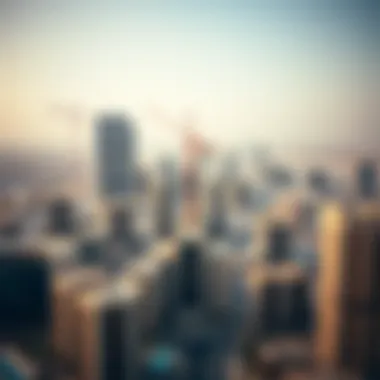

"Dubai's commitment to overcoming its challenges speaks volumes about its resilience and innovation. Stakeholders who are mindful of these urban challenges hold the keys to future prosperity."
As stakeholders navigate these complexities, recognizing the implications of economic fluctuations and environmental factors will be vital in understanding the future trajectory of Dubai’s cityscape. Through both challenges and opportunities, the narrative of Dubai continues to unfold, marked by a resilience that sparks intrigue and investment.
Emerging Trends in the Real Estate Sector
The real estate market in Dubai is undergoing significant transformation, and these changing trends are vital to understand for anyone looking to invest, buy a home, or even just keep their finger on the pulse of this vibrant city. The increase in both the local and global populations has reshaped demand, leading to new living arrangements and innovations in property management.
Real estate is not just about bricks and mortar; it's about the lifestyle and values it represents. Understanding these emerging trends provides crucial insights that can guide investors and homebuyers towards smarter decisions that align with market dynamics and future developments.
The Rise of Co-Living Spaces
In recent years, co-living spaces have burgeoned in Dubai, catering to a demographic increasingly drawn to communal living settings. This model is particularly appealing to younger expats and professionals who favour a shared lifestyle. With the cost of living on the rise, co-living offers a feasible yet stylish alternative to traditional housing arrangements.
The essence of co-living revolves around shared amenities and communal experiences. It’s not just a bedroom; it’s a community where residents can share kitchen space, coworking areas, and relaxation zones.
- Affordability: Co-living spaces tend to be priced lower than renting an individual apartment, making them attractive for individuals moving to the city.
- Flexibility: Many co-living arrangements offer short-term rental options, which is beneficial for those not ready to commit to long leases.
- Networking Opportunities: Living among diverse groups provides connections and opportunities that might not arise in traditional housing.
The demand has resulted in initiatives from developers such as AYA Properties and The Collective, aiming to create spaces that feel less like a rental and more like a home.
Technology's Influence on Real Estate
Advancements in technology are altering how real estate operates in Dubai. Homebuyers and investors can now leverage tech tools that streamline processes and enhance their experiences. Among these innovations are virtual tours and AI applications that mark a leap forward in property management.
Virtual Tours
Virtual tours have reshaped property viewing experiences. Imagine a prospective buyer in New York able to explore an apartment in Dubai without stepping foot in the country. This innovation reflects a growing trend towards digital solutions that save time and resources.
- Key Characteristic: Virtual tours allow potential buyers to navigate spaces as though they are physically present. They can view details and layouts that might not be captured in standard photographs.
- Benefits: This method is not only convenient but also opens up possibilities for investors from overseas who may not have the luxury of visiting each property. Location choices are expanding, becoming less about distance and more about available amenities and community vibe.
However, some buyers might feel that virtual tours lack the tactile experience of physically being in a space, leading to doubts about the accuracy of the presentation.
Usage of AI in Property Management
The integration of AI in property management is beginning to pick up steam in Dubai’s real estate sector, assisting landlords in managing their properties more efficiently. AI tools can analyze data trends, predict market shifts, and even automate mundane tasks.
- Key Characteristic: AI implements algorithms that learn from tenant behaviours, which enhances decision-making for property managers.
- Benefits: The primary advantage of AI lies in its ability to reduce costs and improve tenant satisfaction through personalized service. Imagine a software managing maintenance requests or tracking rental payments seamlessly.
Despite its promising features, there is a learning curve. Not all property managers are tech-savvy, and some may hesitate to embrace AI-driven management tools due to perceived complexities.
In summary, emerging trends like co-living spaces and the infusion of technology into real estate operations reflect a shift towards innovation and community. They offer significant benefits in affordability, flexibility, and efficiency, while also presenting new challenges and considerations in this dynamic city.
Looking Ahead: The Future of Dubai's Cityscape
The ever-evolving landscape of Dubai presents a fascinating tapestry in which the threads of innovation, culture, and sustainability are intricately woven together. As this desert metropolis continues to grow, understanding its future becomes vital not only for residents but also for investors and global stakeholders. The outlook for Dubai's cityscape is marked by ambitious visions, a need for adaptability, and the resilience of its urban environment.
Vision for
Dubai has set its sights on a bold vision for 2040, aiming to position itself as a global leader in various domains, including tourism, technology, and sustainability. This vision lays out several comprehensive goals such as:
- Sustainable Urban Development: Plans are in place to ensure that future developments are eco-friendly, promoting reduced carbon footprints and increased use of renewable energy.
- Enhanced Connectivity: The future city will focus on improved transport systems, from expanded metro lines to efficient road networks that ease commuting and enhance access across the emirate.
- Cultural and Recreational Spaces: Projects like parks, museums, and entertainment hubs are set to give a new lease on leisure, allowing residents and visitors to enjoy a balanced lifestyle amid urban hustle.
Realizing the 2040 vision involves enormous investments, but sectors like real estate and tourism are expected to thrive under this direction, creating new opportunities for stakeholders.
Potential Challenges and Adaptations
However, the path towards this ambitious future is not without hurdles. To ensure progress continues unobstructed, two significant themes merit attention: climate resilience and urban density management.
Climate Resilience
As climate change poses significant risks globally, climate resilience in Dubai's cityscape emerges as a necessity rather than an option. This involves proactively adapting urban design to withstand extreme weather events and rising temperatures. Key characteristics of climate resilience include:
- Water Resource Management: Dubai is known for its scarce water resources, hence, implementing advanced irrigation systems and wastewater recycling becomes crucial. This not only mitigates the effects of drought but also promotes sustainable water use.
- Temperature Regulation Strategies: Shade structures, green roofs, and urban trees can act as natural coolants, helping to lower the overall temperatures across the urban landscape.
The unique advantage of focusing on climate resilience is the potential to establish Dubai as a benchmark for other cities grappling with similar challenges, while also attracting eco-conscious investors. However, these adaptations do come with their challenges, such as high initial costs and the need for continuous maintenance.
Urban Density Management
With an increasing influx of population, managing urban density efficiently becomes a pressing issue. It revolves around balancing residential needs with land availability while ensuring the quality of life for Dubai’s residents. Key attributes include:
- Mixed-Use Developments: Encouraging environments where residential, commercial, and recreational spaces coexist can lead to more vibrant communities and reduce the need for long commutes.
- Smart Urban Planning: Incorporating technology into urban planning allows for data-driven decisions that can optimize space usage and enhance the living experience.
Nonetheless, the approach presents its unique challenges. High density could lead to overcrowding and strain on public services if not managed effectively. Strict regulatory measures and community involvement in planning are crucial.
"Adopting a forward-thinking approach to urban challenges can catalyze transformative change in Dubai’s cityscape, leading to not just adaptation but flourishing resilience."
